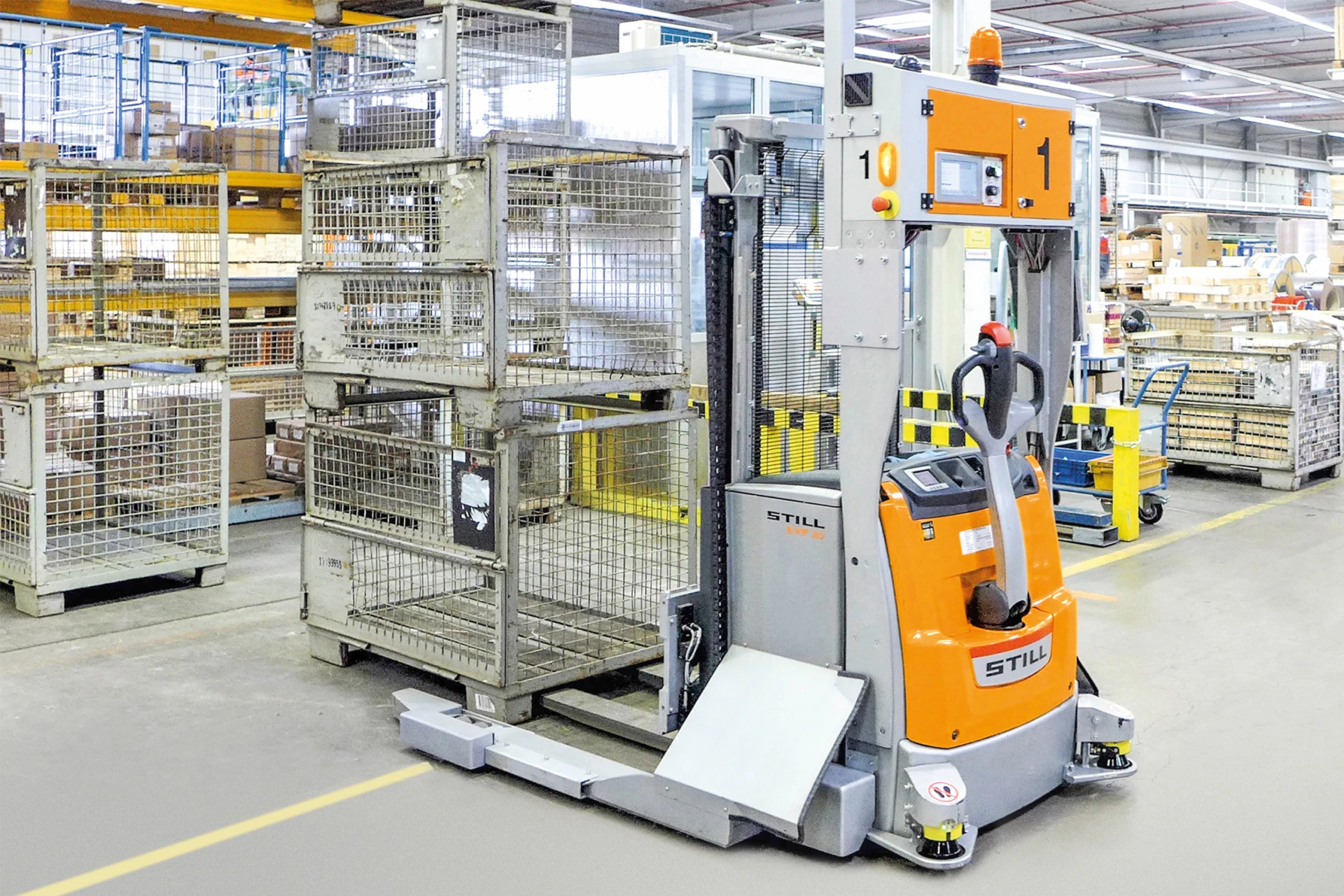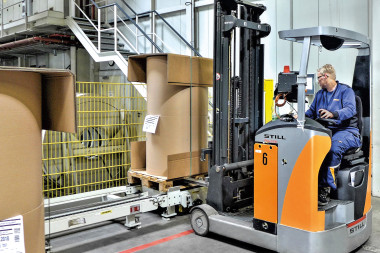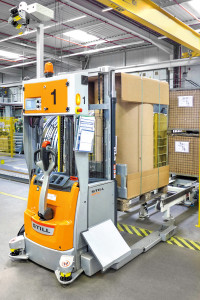Automated transport from incoming goods to production
Safe material transport with automated industrial trucks from STILL in mixed traffic.
Sector: Construction components
Company: Thirty-eight specialised plants in Europe, North America and Asia. More than 6000 employees. Revenue: over one billion euros.
Challenges: Efficient and safe material supply to the production areas with standard load bearers.
STILL products: Connection to SAP control system (driving instructions). STILL EXP 20 automated high lift pallet truck (via magnet points) incl. personal protective equipment (Sick scanner) for people or objects nearby.

Hörmann KG relies on automated processes for a more efficient
production supply.
With more than 13 million Berry up-and-over garage doors, the Hörmann Group is one of the market leaders for a variety of gates and doors for use in private and commercial properties. The family company was founded by August Hörmann in 1935 under the name ‘Bielefelder Stahltore’, and now produces at a total of 38 sites in Europe, North America and Asia. In order to supply the market with high quality garage and sectional doors, in 1998 Hörmann KG built a plant with ten warehouses and production halls in Ichtershausen, Thuringia, Germany.
Customer-oriented advice and service
The Hamburg-based logistics system provider STILL was on board from the outset. These days, roughly 30 different STILL industrial trucks are in operation at the Hörmann plant in Thuringia. Conveniently, the STILL rental and service centre for the Erfurt region is also located in Ichtershausen. These two highly innovative companies regularly exchange their experiences with rational transport technologies. “After the owner family, who are always on the lookout for innovations for their company, had seen driverless transport systems (DTS) in other companies”, emphasises Head of Internal Logistics Ronny Weißenborn, “we looked at whether DTS could also be beneficial for material supply in the production areas. This was effectively when we started working together to look for an efficient solution.”
Automated STILL industrial truck tested
“In a two-day test operation at the end of 2015, STILL used an automated high lift pallet truck to show how conventional forklift truck transport could be carried out by standard load bearers with a high level of reliability”, explains STILL System Consultant Hansjürgen Schnabel. The test was impressive, and so the decision was made in August 2016. The goods are transported gently. The precise truck navigation avoids damage to shelving.
The aim was to commission the system after a planning and implementation period of just five months. It was intended that the time around the turn of the year would
be used to set up the DTS system, as it was planned that servicing would be carried
out on the production equipment at that point. Operations started in the second calendar
week of 2017. Hansjürgen Schnabel stresses, “We were only able to achieve
this goal because all of the specialists involved in the project understood each
other perfectly and collaborated smoothly from the outset. In particular, the precise
guidelines from Hörmann conveyed by Ronny Weißenborn made this extremely quick
implementation possible.“
Material provision for production optimised
According to Ronny Weißenborn, “Every day, we unload an average of 30 lorries
between 06:00 and 14:00, using STILL forklifts of course.“ Goods are posted in the
SAP system in incoming goods and labelled with a warehouse code. Standard pallets
or grid boxes are then transported to the buffer station for the production supply.
The automated supply process for the production areas starts with the transfer of
the goods on pallets from the buffer station to an automatic chain conveyor via STILL
FM-X 14 driver seated reach trucks. The warehouse label is scanned on the way to
the chain conveyor. During this process, the data is sent to the SAP control system,
which generates the transport order for the DTS on the basis of a STILL EXP 20 high
lift pallet truck. In order to receive the goods from the chain conveyor, this moves its
forks into the load-carrying equipment.
Reliable material flow
“The automation enabled us to reorganise the transport processes, for example
using a one-way system. Due to the busy mixed traffic, this offers the best technical
safety conditions“, explains Ronny Weißenborn.
The EXP 20 finds the route to the respective supply location for production via the
master controller using magnetic points recessed into the floor. It has also been
equipped with various safety modules. These include Sick scanners, which stop
the DTS if there is a person or an object nearby. Two additional Sick scanners are
installed above this. They act like a safety curtain. This enables the reliable detection
of hazards in the upper area.
Expansion of the supply and disposal process possible
Currently, the EXP 20 moves to twelve destinations across a total route of 600
metres in two halls. After putting down the goods, it picks up empty pallets that have
been placed on the return route and deposits them in the incoming goods area. The
twelve destinations are bays, for example for the production of side doors, frames
and windows. There are also bays for the provision of materials for the packaging of
doors and bays for depositing empty pallets.
“As the automated supply and disposal process is working so well“, says Ronny
Weißenborn, “we also want to include the rubbish containers from production in the
DTS cycle.“ The employees tell the SAP system if they have deposited a grid box or a
rubbish container.
Process reliability round the clock
The automated transport process runs round the clock. However, the automation
has not just resulted in process reliability; it also ensures error-free transport. “In
total, three employees have been able to take on other challenging work“, highlights
Ronny Weißenborn.
The regular process means that fewer kilometres are travelled along the route, freeing
up valuable time for productive tasks. For example, there is no need for forklift
trucks to go on search trips to collect deposited pallets and rubbish containers.
Hansjürgen Schnabel explains, “The DTS works at a noticeably lower speed
(1.4 m/s) than manually driven forklift trucks. However, it is working constantly,
meaning that it is more productive. As it is a series truck which was automated at
a later date, the EXP 20 can also be used in dual operation (automated or manual).
This results in higher availability for the supply to production.“
Summary
Due to the consistent, slower driving, there is a considerable reduction in servicing
and repair costs in comparison with manually driven forklift trucks. There is also a
noticeable increase in usage time. Last but not least, the DTS operation takes place
without damage being caused by collisions with buildings and equipment.
The team around Ronny Weißenborn at Hörmann wants to expand the automated
transport. It will then also include automated battery charging. Ronny Weißenborn
states, “We are confident that we will also be able to implement this project on
time.“





